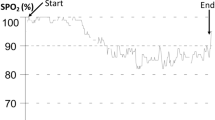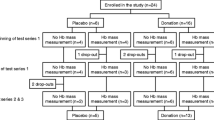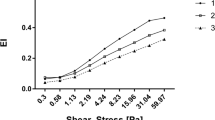Summary
20 male elite long distance runners were compared to a control group of blood donors to determine the effect of training on red blood cells. The acute effects of exercise on red cells were investigated in 11 of the runners following a race of 15–30 km. The runners had elevated resting values of red cell 2,3-DPG (P<0.05) and mean cell volume (P<0.01); blood Hb and ATP were not different from concentrations in the control group. The red cell status of the athletes may be explained by an increased proportion of young erythrocytes in runners. No statistically significant changes in red cell 2,3-DPG, ATP, mean cell volume or blood Hb were found post exercise.
Similar content being viewed by others
References
Adams H (1963) Adenosine 5′-triphosphate, determination with phosphoglycerate kinase. In: Bergmeyer HU (ed) Methods of enzymatic analysis. Academic Press, New York, pp 539–543
Austin PK, Stegink LD, Gisolfi CV, Lauer RM (1973) The effect of exercise on red blood cell 2,3-diphosphoglycerate in children. J Pediatrics 83: 41–45
Bernstein RE (1959) Alterations in metabolic energetic and cation transport during aging of red cells. J Clin Invest 38: 1572–1586
Bonsignore G, Rizzo A, Sciarabba G, Mirabella A, Bellia V (1980) Effect of muscular exercise on the affinity for oxygen of whole blood in healthy men and in bronchitis patients. Bull Eur Physiopathol Resp 16: 229–237
Bunn HF, Jandl JH (1970) Control of hemoglobin function within the red cell. New Engl J Med 282: 1414–1421
Ericson å, Verdier C-H de (1972) A modified method for the determination of 2,3-diphosphoglycerate in erythrocytes. Scand J Clin Lab Invest 29: 85–90
Fornaini G, Dacha M, Accorsi A, Fazi A, Piatti E (1981) Glucose utilization in human erythrocytes during physical exercise. Med Sci Sports Exerc 13: 322–324
Forrester T (1979) Extracellular nucleotides in exercise: Possible effect on brain metabolism. The Physiologist 22: 50–58
Haidas S, Labie D, Kaplan J-C (1971) 2,3-diphosphoglycerate content and oxygen affinity as a function of red cell age in normal individuals. Blood 38: 463–467
Hegenauer J, Strause L, Saltman P, Dann D, White J, Green R (1983) Transitory hematologic effects of moderate exercise are not influenced by iron supplementation. Eur J Appl Physiol 52: 57–61
Hoyt RW, Wood SC, Hicks JW, Asakura T (1983) Effects of long distance running at high altitude on the standard oxygen-hemoglobin dissociation curve and red cell 2,3-DPG. Eur J Appl Physiol 51: 175–181
Hunding A, Jordal R, Paulev P-E (1981) Runner's anemia and iron deficiency. Acta Med Scand 209: 315–318
Keitt AS (1971) Reduced nicotinamide adenine dinucleotide-linked and fluorometric procedures. J Lab Clin Med 77: 470–475
Klein JP, Forster HV, Stewart RD, Wu A (1980) Hemoglobin affinity for oxygen during short-term exhaustive exercise. J Appl Physiol 48: 236–242
Kunski H, Sztobryn M (1976) The effect of physical exercise on 2,3-DPG concentration in erythrocytes. Acta Physiol Pol 27: 292–299
Maeda N, Chang H, Benesch R, Benesch RE (1971) A simple enzymatic method for the determination of 2,3-DPG in small amounts of blood. New Engl J Med 284: 1239–1242
Meen HD, Holter PH, Refsum HE (1981) Changes in 2,3-DPG after exercise. Eur J Appl Physiol 46: 177–184
Paulev P-E, Jordal R (1983) Dermal excretion of iron in intensely training athletes. Clin Chim Acta 127: 19–27
Puhl JL, Runyan WS (1980) Hematological variations during aerobic training of college women. Res Q Exerc Sports 51: 533–541
Rahe AJ (1974) Tables of critical values for the Pratt matched pair signed rank statistic. J Am Statis Assoc 69: 368–373
Remes K, HÄrkönen M, Vuopio P, Peltokallio P (1975) The decrease in red cell 2,3-DPG concentration in long distance running. J Sports Med 15: 113–116
Remes K (1979) Effect of long-term physical training on total red cell volume. Scand J Clin Lab Invest 39: 311–319
Remes K, Vuopio P, HÄrkönen M (1979) Effect of long-term training and acute physical exercise on red cell 2,3-diphosphoglycerate. Eur J Appl Physiol 42: 199–207
Taunton JE, Taunton CA, Banister EW (1974) Alterations in 2,3-DPG and P50 with maximal and submaximal exercise. Med Sci Sports 6: 238–241
Torrance J, Jacobs P, Restrepo A, Eschbach J, Lenfant C, Finch CA (1970) Intraerythrocytic adaptation to anemia. New Engl J Med 283: 165–169
Thomson JM, Dempsey JA, Chosey LW, Shahidi NT, Reddan WG (1974) Oxygen transport and oxyhemoglobin dissociation during prolonged muscular work. J Appl Physiol 37: 658–664
Author information
Authors and Affiliations
Rights and permissions
About this article
Cite this article
Brodthagen, U.A., Hansen, K.N., Knudsen, J.B. et al. Red cell 2,3-DPG, ATP, and mean cell volume in highly trained athletes. Europ. J. Appl. Physiol. 53, 334–338 (1985). https://doi.org/10.1007/BF00422849
Accepted:
Issue Date:
DOI: https://doi.org/10.1007/BF00422849




